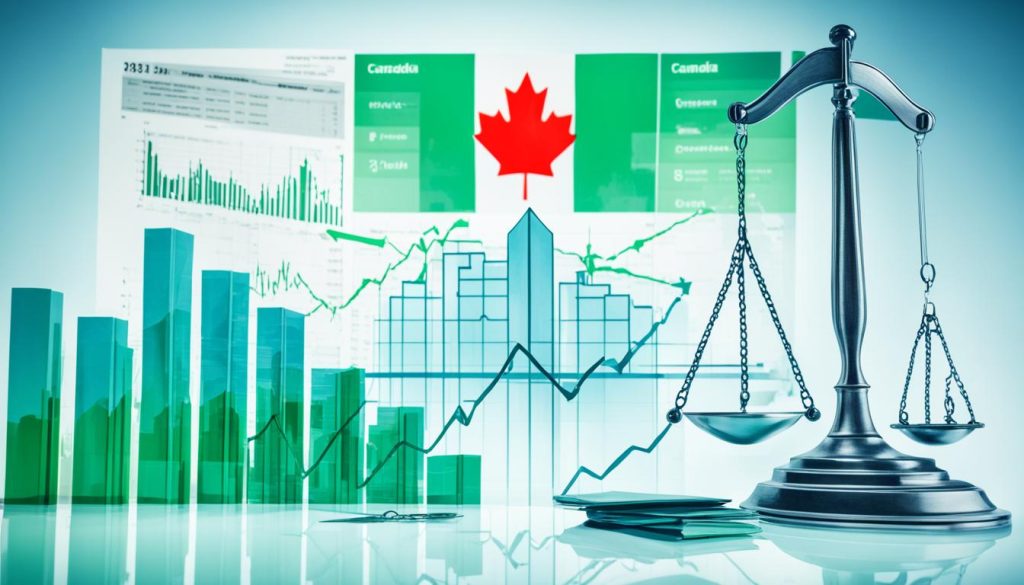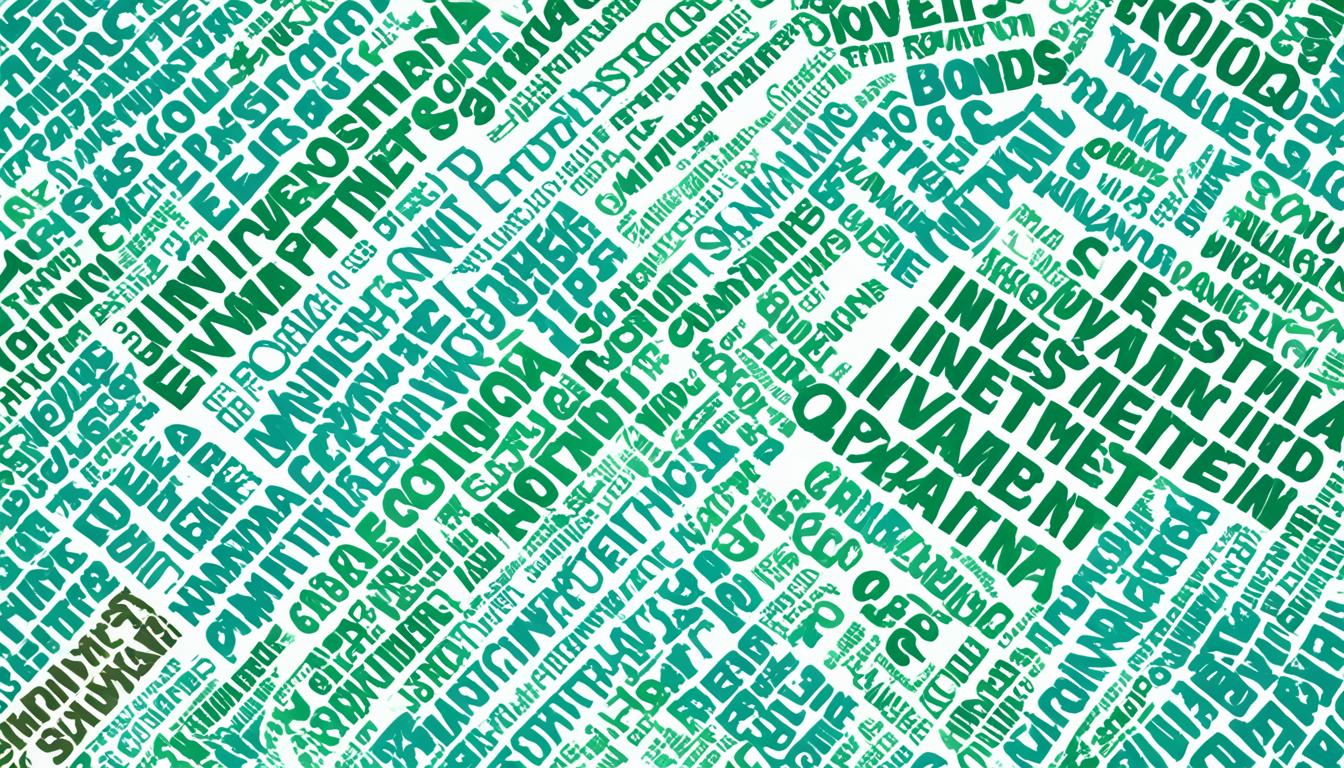Canadians have a wide range of investment options, from low-risk savings to high-potential stocks. With smart investing, you can boost your wealth and ensure financial security. This guide shows the best places to put your money in Canada, whether you’re starting with $1,000 or more.
Investing in Canada means following rules set by various authorities. Each province has its own securities regulator. It’s key to think about your money status, what you want to achieve, how long you can invest, and your risk comfort. Matching your plans with tools like RRSPs and TFSAs can help a lot.
Discover the best Canadian investments, from safe This listing highlights 11 great ways to invest. If you want to grow your income or play it safe, find advice here. Learn how to make smart choices for your financial future.
Investments Regulations in Canada
Investments in Canada fall under the watchful eyes of many regulators. The securities regulators in each area look after things like mutual funds and stocks. They’re there to help by sharing lots of resources on types of investments.
Securities Regulators by Province and Territory
Every part of Canada, from provinces to territories, has its own securities regulator. They make sure investment rules are followed. These groups offer lots of help, like how to invest smartly and what kind of investments are out there.
Factors to Consider Before Investing
Thinking before you invest is key. Canadians should look at their money situation, what they want to do with their investment, and how much risk they’re okay with. Understanding these helps pick the best investment options in Canada for their goals.
Resources on Types of Investments
For insights into types of investments in Canada, check out your local securities regulator’s site. They’re full of info and tools to figure out what might work for you. This includes learning about risks and how to actually start investing.

Understanding Investment Costs
Investing in Canada means knowing about the different costs tied to your investments. These costs can really impact how much you make from your investments. You’ll pay costs when you buy, sell, and manage what you’ve invested in.
Common Investment Costs
Here are some usual costs you might face when investing in Canada:
- Management Fees: These are charged by banks or managers to handle your investments.
- Trading Commissions: You pay these when you deal with stocks, bonds, or other things.
- Expense Ratios: They’re like ongoing charges for mutual funds and ETFs to pay their costs.
- Account Maintenance Fees: Financial institutions might charge these to keep your account.
- Redemption Fees: If you sell an investment early, you might have to pay these.
Investment Fee Calculators
Luckily, some Canadian securities regulators have online tools that are free. These calculators help you see how fees can affect your investments over time. The Ontario Securities Commission (OSC) and the British Columbia Securities Commission (BCSC) have these tools. You enter your investment info and the calculators show you the fee impact on your returns.

By knowing and using these tools, you can plan your investment better. This way, you can ensure your money is helping you reach your goals as much as possible.
Taxation of Investments in Canada
Investing in Canada means understanding the tax rules for different types of investments. The way investments are taxed can be quite different. Knowing the tax rules for different investment types in Canada helps you make smart choices and get the most out of your money.
Tax Rules for Different Investment Types
The tax you pay on investments in Canada changes by what you invest in. For instance, money you make from a savings account acts as regular income. But if you sell stocks or mutual funds, any profit is seen as a capital gain and taxed differently.
Accounts like the RRSP and TFSA offer ways to grow your money without paying taxes later. With these accounts, you might not pay taxes on the money you make. This can make a big difference in how much your investments grow over time.
Because the tax rules can get complicated, it’s wise for Canadians to get help from experts. Financial advisors or tax specialists can make sure you understand the tax rules for different investment types in Canada. They can also help you plan how to invest your money smartly.

By learning about the taxation of investments in Canada and working with financial advisors, Canadians can improve their investment strategies. This helps to make the most of their financial future.
Resolving Investment Complaints
If you have issues with investments or are worried about your financial advisor, help is available in Canada. You can resolve investment complaints with the help of several organizations. They make it easier to file investment complaints properly.
Where to File Investment Complaints?
For different types of complaints, you have multiple options to seek help. You can contact your province’s securities regulator, the OBSI, or the FCAC. Each of these can offer a hand depending on your situation.
Your local securities regulator is key for filing investment complaints in Canada. They deal with issues involving investment firms, advisors, and their products. You can easily find your regulator’s contact info online.
The OBSI is an outside body that looks into disagreements with financial firms, like investment companies. If direct discussions with your firm are not working, contacting the OBSI might help.
The FCAC gives advice on resolving investment complaints in Canada. They don’t solve complaints directly, but they can guide you. They help you know your rights and show you where to file investment complaints.

Where to Invest Money in Canada?
In Canada, it’s key to use special savings and investing vehicles to meet financial goals sooner. The RRSP, TFSA, and RESP offer tax benefits. They help Canadians grow their money and avoid heavy taxes.
Tax-Advantaged Accounts for Investing
With RRSPs, money is put in before taxes, grows tax-free, and is taxed later. TFSAs use already taxed money, but profits and withdrawals are tax-free. RESPs assist in saving for a child’s education, with government grants and tax benefits.
Aligning Investments with Time Horizons
Choosing where to invest money in Canada means looking at goals, risk level, and time. This ensures a portfolio fits personal needs and aims. It might be for future education, retirement, or other plans.
Finding a Canadian Bank for Investing
Many start investing in Canada with their local bank. It gives access to various saving and investment tools. This includes mutual funds, stocks, ETFs, and advice. A good Canadian bank makes investing simpler and more successful.
Getting Started with Investing in Canada
Want to start investing in Canada? The good news is, you don’t need a lot of money. Many investment products here have low starting costs. Some need as little as $500, and others have no minimum at all. This makes starting investing in Canada easy, even if you don’t have much to start with.
Minimum Investment Requirements
Canada’s low investment requirements mean you can start investing with little money. It’s a great way for beginners to start. You can learn with small amounts and grow from there. Investing this way builds experience without risking a lot of money.
Determining How Much to Invest
How much to invest in Canada depends on many things. Your finances, goals, and time are key. The second source suggests talking to a financial advisor. They can help create a personalized investment plan just for you.
Savings and Investment Options in Canada
Canada has many options for saving and investing to support people’s financial goals. These include savings for retirement, education costs, and buying a home. The country provides special accounts that give tax benefits and other advantages.
Tax-Free Savings Account (TFSA)
A TFSA is a special account where Canadians can save and invest money without taxes on growth or when they take it out. You put in money you’ve already paid tax on. But, the good news is, it’s tax-free when you take it out. The most you can put in each year is $6,500 (as of 2023), and if you don’t use the room, you can save it for later.
Registered Retirement Savings Plan (RRSP)
An RRSP is a way to save for retirement while getting a tax break now. You can deduct what you put in from your taxable income. The money you make in the account grows tax-free until you use it. For 2023, you can contribute up to 18% of last year’s income, which is capped at $30,780.
Registered Education Savings Plan (RESP)
If you want to help with a child’s education costs, an RESP is a great choice. Money in this account can grow without being taxed. When used for school, the withdrawals are usually tax-free too. Plus, the government adds to what you save through things like the Canada Education Savings Grant.
Registered Disability Savings Plan (RDSP)
The RDSP is for those with disabilities looking to save for the long term. Unlike an RRSP, the money put in isn’t tax-deductible. However, it grows without being taxed and isn’t taxed when it’s taken out for disability-related costs. Government help, like grants and bonds, is available to increase savings here.
Tax-Free First Home Savings Account (FHSA)
New in 2022, the FHSA is set up to save for a first home with tax benefits. You can deduct contributions from your taxable income. When the time comes, pulling the money out for a home is tax-free. The yearly limit is $8,000, but you can save up to $40,000 over the years.
Best Investment Options for Canadians
Canada offers many investment paths with varying levels of risk and reward. This guide shows 11 top options ranked by their risk level.
1. High-Yield Savings Accounts
High-yield savings accounts are a great choice for low-risk growth. They earn more interest than regular accounts. This makes them perfect for saving money in the short term. Look to many banks and financial companies for accounts with good rates.
2. Certificates of Deposit (CDs)
CDs are a secure investment in Canada. They promise a fixed interest rate and have a specific end date. This setup is ideal for those wanting sure returns on their money. Canadian banks and credit unions have various CD choices with unique term lengths and rates.
3. Bonds
Many Canadians choose government or corporate bonds for a steady income. They’re generally safer than stocks. You can buy bonds yourself or through funds that focus on them.
4. Mutual Funds
Mutual funds are popular in Canada. They offer a mix of stocks, bonds, and more, managed by experts. This mix can bring decent returns but carries some risk.
5. Exchange-Traded Funds (ETFs)
ETFs are an easy and cheap way to invest in various assets. They follow different markets or themes. This allows for a spread out investment with one buy. You can trade ETFs on the TSX.
6. Stocks
Buying stocks could lead to big gains but is riskier. Stocks can jump or drop suddenly. Canadians can buy them through web brokers, automated advisories, or with help from a financial advisor.
When selecting an investment, Canadians should match their goals and risk level. Tailor a diverse portfolio that suits your specific situation.
Conclusion
This article dove into the world of investing in Canada. It looked at the rules, costs, and choices available. Canadians can pick from many investment options. These range from safe accounts to risky stocks and property.
It’s key to pick investments that match your goals and how much risk you’re okay with. Also, think about how long you plan to keep your money in.
Using special tax accounts like TFSAs and RRSPs can be a smart move. They make it easier to save money and avoid some taxes. Working with a good bank or expert can help you manage your money wisely.
Looking to where to invest money in Canada or the best investment options in Canada? This guide offers help. It shares tips and ways to make smart money choices.
Don’t forget investing needs thought and checking. Talking to experts before big choices is a good idea. With a smart plan and a focus on the future, Canadians can better their financial life through investing.




